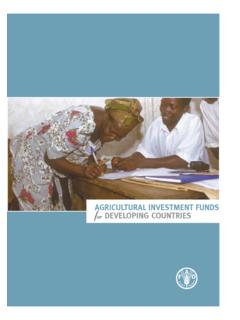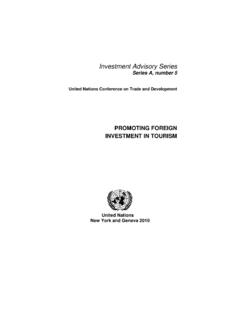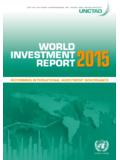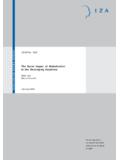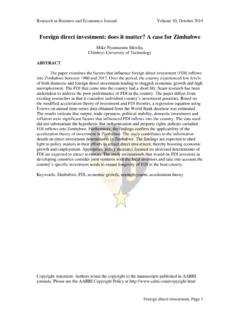Transcription of Analysis of FDI Flows to Developing Countries: Is the MENA ...
1 Analysis of FDI Flows to Developing countries : Is the MENA Region different ? steve onyeiwu , Abstract FDI Flows to the MENA region have been disappointing relative to other Developing countries . Using fixed effects panel regressions, this paper investigates whether the determinants of FDI affect MENA countries differently. The results indicate that some of the variables that influence FDI Flows to Developing countries are not important for Flows to MENA countries . These include the rate of return on investment, infrastructures, economic growth, and inflation.
2 While trade openness increases FDI Flows to MENA. countries , corruption/bureaucratic red tape were found to reduce Flows to the region. Thus, trade liberalization and privatization are important preconditions for FDI Flows to the region. KEYWORDS: Foreign Direct Investment, Returns on Investment, Trade Liberalization, Capital Flows , Institutions. Assistant Professor of Economics, Allegheny College. Address: 520 North Main Street, Meadville, Pennsylvania 16335, USA. E-mail: . Telephone: (814) 332-3338, Fax: (814) 332-2310.
3 2. Analysis of FDI Flows to Developing countries : Is the MENA Region different ? steve onyeiwu , *. Assistant Professor of Economics, Allegheny College. Address: 520 North Main Street, Meadville, Pennsylvania 16335, USA. E-mail: . Telephone: (814) 332-3338, Fax: (814) 332-2310. * Acknowledgment: I wish to thank Dr. Hemanta Shrestha, Dr. Behrooz Afrasiabi and Donald A. Vrabel for their valuable research assistance. Needless to say, I am solely responsible for any errors in the paper. 3. 1. INTRODUCTION. The Middle East and North Africa (MENA) region represents an exasperating paradox with regard to the flow of Foreign Direct Investment (FDI).
4 Despite being home to some of the richest oil-producing countries in the world and almost two decades of implementation of structural adjustment, the region continues to attract abysmal Flows of FDI (Rivlin, 2001, pp. 190-192). In the 1990s, for instance, the average FDI/GDP ratio for MENA was percent, compared to percent and 2 percent in East Asia and Latin America, respectively. Since the mid-1980s, FDI/GDP ratio in MENA has hovered between percent and percent, whereas it has been over 1 percent in Asia (Bisat, 1996, ).
5 To explain the differences in the flow of FDI among Developing countries , some analysts point to the salience of democracy, transparency and good governance, while others emphasize the need for a stable macroeconomic environment and the capacity for economic management (World Bank, 1997, IMF, 2001, pp. 49-50). More recently, new institutional economists have extolled the role of institutions such as property rights, the tax system, the rule of law, and economic freedom in mobilizing both foreign and domestic capital for growth and development (Collier and Gunning, 1999, El-Naggar, 1990).
6 Given the unsatisfactory performance of the MENA region relative to other regions , it becomes imperative to investigate whether the determinants of FDI affect MENA countries differently. Using fixed effects panel regressions to control for country- and- time-specific factors, this paper explores whether the stylized determinants of FDI affect FDI Flows to the MENA region differently. It also investigates whether there are region-specific institutional factors that are significant for FDI Flows to the region, and highlights the policy options available to MENA countries in their quest to promote growth and development via The paper differs from previous studies on FDI Flows to the MENA region in the following ways.
7 First, it compares MENA countries with other Developing countries in order to identify idiosyncratic features of MENA economies that may affect FDI Flows . Second, it uses panel regressions covering the period 1975-1999. Third, it considers both institutional and macroeconomic determinants of FDI Flows to the region. 2. FDI Flows TO THE MENA REGION. The past decade or so has witnessed a substantial increase in the stock of FDI. around the world. In Developing countries alone, the stock of FDI increased from about $10 billion in 1986 to over $99 billion in 1995 (UNCTAD, 1997).
8 However, compared to other regions of the world, the MENA region has attracted only a small proportion of the global stock of FDI. Table 1 shows that the FDI/GDP ratio in the MENA region was a mere percent in 1996, the lowest of all the regions in the Developing world. Although the FDI/GDP ratio in the MENA region increased to percent in 1998, it has been declining ever since, and has remained below 1 percent. Notice from Table 1. that Sub-Saharan Africa (SSA), which is often regarded as one of the poorest regions in the world, attracted substantially more FDI than the MENA region during the past decade.
9 SSA received about 10 times more FDI than MENA in 1999. In addition to 4. having a very low share of FDI in Developing countries , MENA countries ' share of net private capital Flows has also been meager, as Table 2 indicates. In 1990, (INSERT TABLE 1 & TABLE 2 HERE). MENA countries accounted for a mere percent of net capital Flows to Developing countries , slightly above SSA's share of percent. By 1996, however, MENA. countries had become the lowest recipients, with percent of the There are three distinctive features about FDI Flows to the MENA region.
10 First, much of the Flows is concentrated in a few countries such as Saudi Arabia, Egypt, Tunisia, Bahrain, and Morocco. The least recipients include Libya, Kuwait, and Yemen (Eid and Paua, 2002, ). Second, a preponderance of FDI in the region has gone into petroleum-related (particularly hydrocarbons) and other primary activities. Non- petroleum FDI (especially to countries such as Bahrain, Egypt, Morocco, Tunisia, and Lebanon) has gone into tourism, banking, telecommunications, manufacturing, and construction (Eid and Paua, ).


